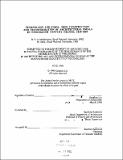Technology and form : iron construction and transformation of architectural ideals in nineteenth century France, 1830-1889.
Author(s)
Lee, Sanghun
DownloadFull printable version (63.02Mb)
Alternative title
Iron construction and transformation of architectural ideals in nineteenth century France, 1830-1889
Advisor
Stanford Anderson.
Terms of use
Metadata
Show full item recordAbstract
This dissertation investigates the transformation of architectural ideals brought about by the development of iron construction during the nineteenth century in France. The emergence of iron construction paralleled the crisis of neoclassicism, in which an ambiguous compromise between classical formal norms and modem science and technology was already manifest in the iron reinforced lintel. In the crisis of neoclassicism, iron, with its impact on both technological and formal aspects of architecture, emerged as a symbolic material to create a new style of modem architecture among utopians and rationalists. However, iron construction could not create a new style on its own; nor did there exist absolute formal aesthetic principles to impose on the construction. This is a fundamental dilemma of modem architecture, an inherent contradiction of bourgeois culture. Structural rationalists during the second half of the nineteenth century tried to resolve this contradiction by attempting to create a new style of architecture based on material and constructional rationality and reason. However, their inability to create a new style was finally proved in the last decade of the nineteenth century when the Art Nouveau exploitation of iron became a passion for individual fantasies, while engineers declared the triumph of their iron construction. Subsequent rationalists' change of the material signifier of architectural modernity from iron to reinforced concrete testified to the fundamental gap between technology and form, and the dilemma of bourgeois rationalism. Early twentieth century modernist historians rediscovered nineteenth century iron construction as a precursor of modem architecture, constructing an evolutionary history of modem architecture based on the rationalist constructive tradition, from iron construction to reinforced concrete architecture. However, their "discovery" of iron construction was purely an aesthetic invention of the twentieth century based on modernist avant garde aesthetics. Behind their apparent reconciliation of modem technology and architecture lay the aestheticization of material and construction, and the subjectivization of architecture. Thus, this dissertation analyzes the displacement of architectural discourses on iron construction from an objective construction to a subjective aesthetics. This shift characterized the further development of modem architecture and its mode of existence in modem society in relation to the development of modem technology.
Description
Thesis (Ph. D.)--Massachusetts Institute of Technology, Dept. of Architecture and Planning, 1996. Includes bibliographical references (leaves 317-339).
Date issued
1996Department
Massachusetts Institute of Technology. Department of Architecture; Massachusetts Institute of Technology. Department of Urban Studies and PlanningPublisher
Massachusetts Institute of Technology
Keywords
Architecture, Urban Studies and Planning